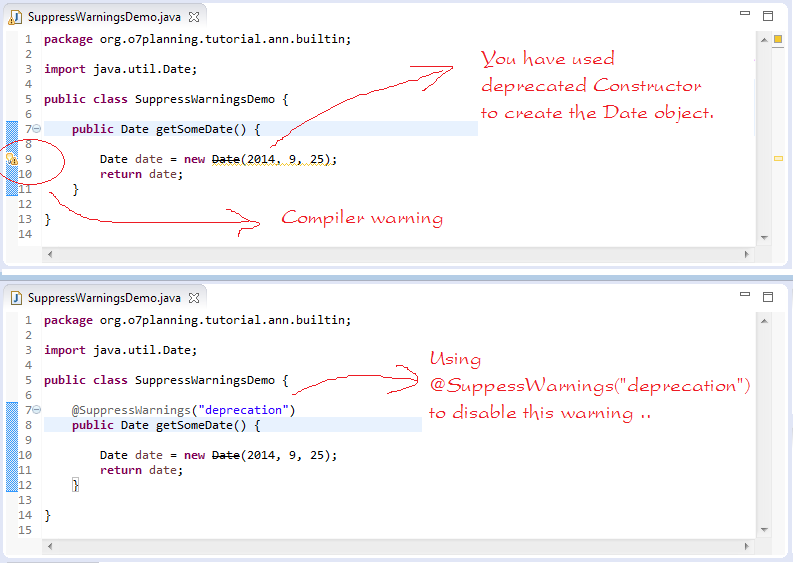
It is important to design your annotation type carefully to ensure that the programmer using the annotation finds it to be as flexible and powerful as possible. For example, you can create a repeatable annotation type that can only be used on methods and fields. It is also possible to define your own annotation type. In the previous examples, Override and SuppressWarnings are predefined Java annotations. It is also possible to restrict where an annotation type can be used by using the meta-annotation. The annotation type can be one of the types that are defined in the java.lang or packages of the Java SE API. It is now possible to use an annotation zero times, once, or, if the annotation's type is marked as more than once. When designing an annotation type, you must consider the cardinality of annotations of that type. Annotations are not pure comments as they can change the way a program is treated by the compiler. instance variables, constructors, methods, classes, etc. attached with class, interface, methods or fields to indicate some additional information which. Annotations help to associate metadata (information) to the program elements i.e. Java Annotation is a tag that represents the metadata i.e. See theĪnnotatedElement class specification for information on all of the available methods. Annotations do not change the action of a compiled program. Other methods were introduced in Java SE 8 that scan through the container annotation to return multiple annotations at once, such asĪnnotatedElement.getAnnotationsByType(Class).
Java annotations code#
In this way, legacy code continues to work. If more than one annotation of the requested type is present, you can obtain them by first getting their container annotation. The behavior of the methods that return a single annotation, such asĪnnotatedElement.getAnnotation(Class), are unchanged in that they only return a single annotation if one annotation of the requested type is present.


Use the above examples to get a headstart on coding in Java with the best practices.There are several methods available in the Reflection API that can be used to retrieve annotations. 🍏 This list nowhere near being comprehensive, but it covers the most basic ones. 🟢 0️⃣ startServer() 1️⃣ createTestLogFile() 2️⃣ test1() 3️⃣ deleteTestLogFile()4️⃣ createTestLogFile() 5️⃣ test2() 6️⃣ deleteTestLogFile() 7️⃣ stopServer()🔴 For example the override annotation is used for instructing compiler that the annotated method is overriding the method. The above code will execute in the order: 1) Instructions to the compiler: There are three built-in annotations available in Java ( Deprecated, Override & SuppressWarnings) that can be used for giving certain instructions to the compiler. These annotations keep the code simple and readable with the power of making changes to the code at runtime. An annotation is a kind of meta data in java which can be applied at various elements of java sourcecode so that later some tool, debugger or application program can take advantage of these annotations and help analyzing the program in positive and constructive way. There are a lot of libraries which use these annotations heavily.


Annotations have no direct effect on the operation of the. Java annotation are really helpful when you want to add some additional information to your class, method or instance variable. If a method marked with override fails to override a superclass method correctly, the compiler generates an error. Annotations, a form of metadata, provide data about a program that is not part of the program itself. While it is not required to use this annotation when overriding a method, it helps prevent errors. Predefined Annotations The informs the compiler that the subclass element is overriding the parent class or superclass element.


 0 kommentar(er)
0 kommentar(er)
